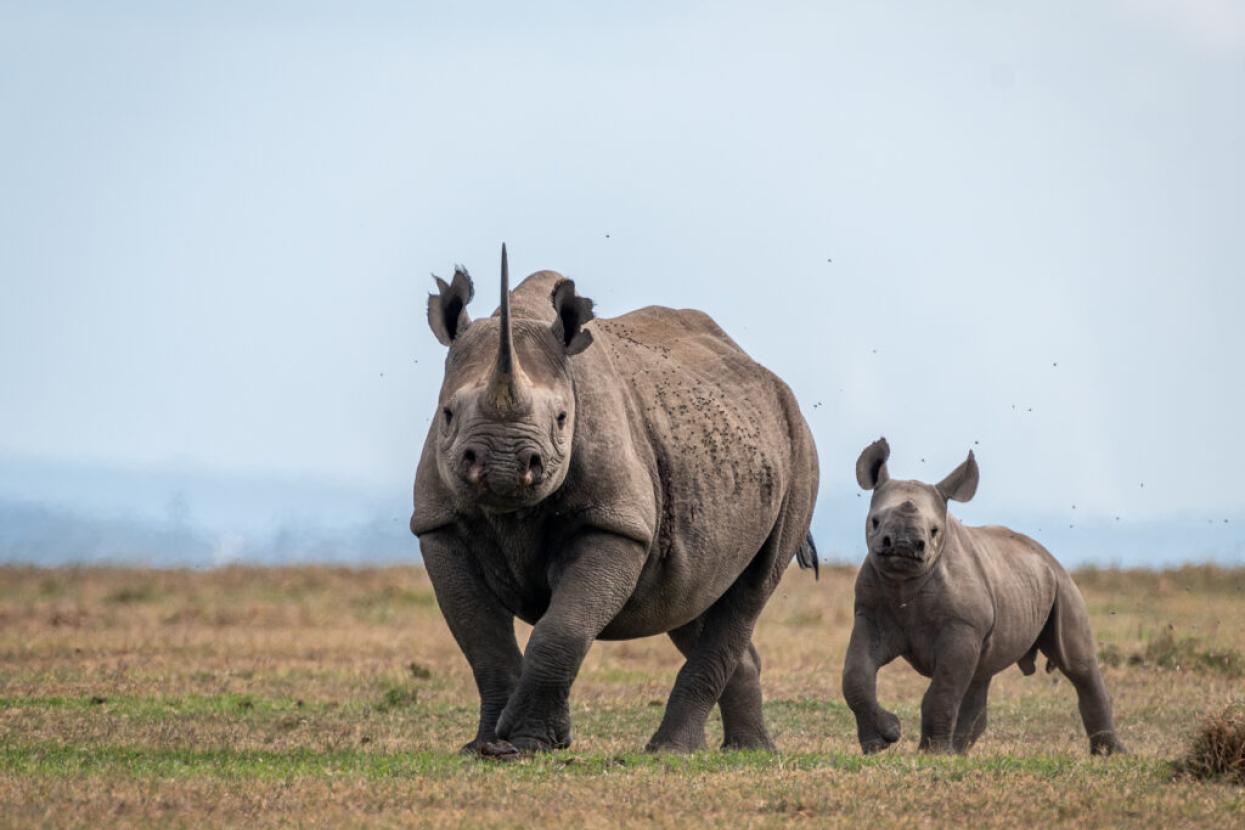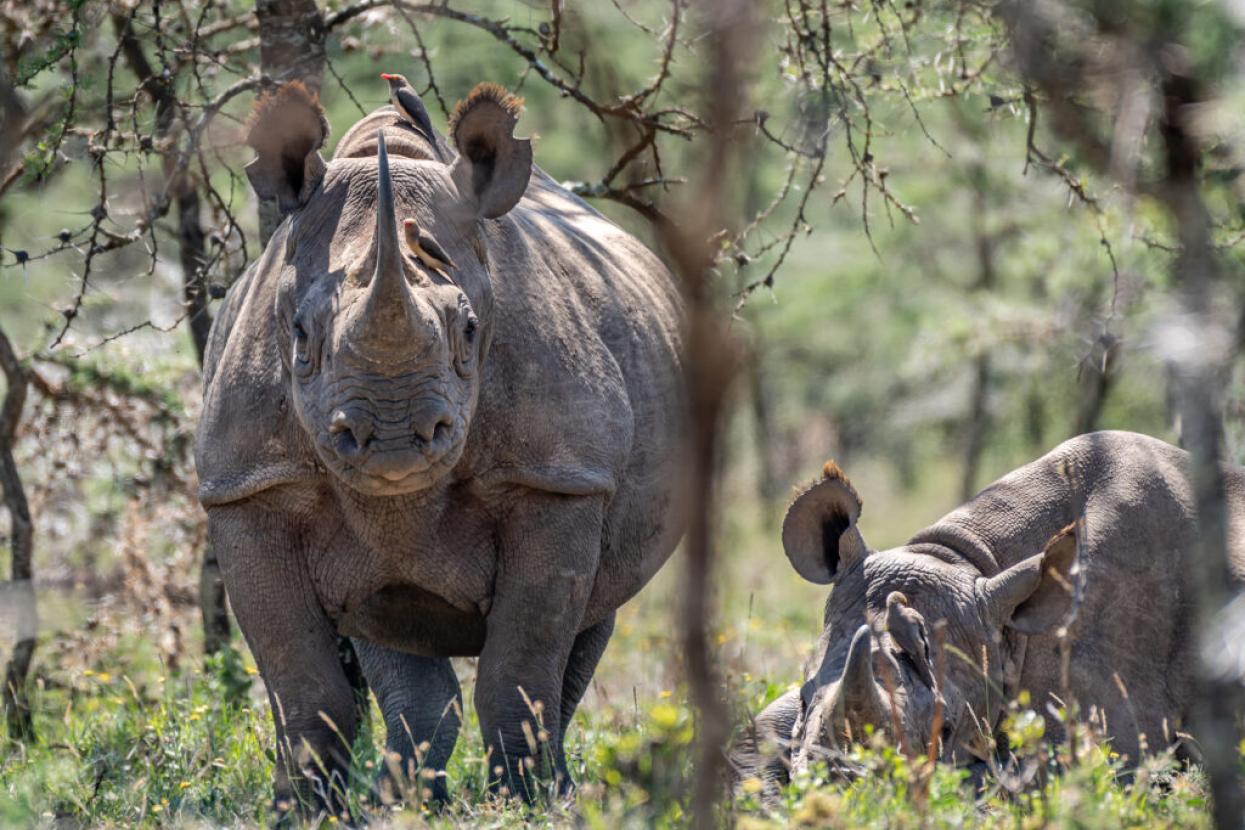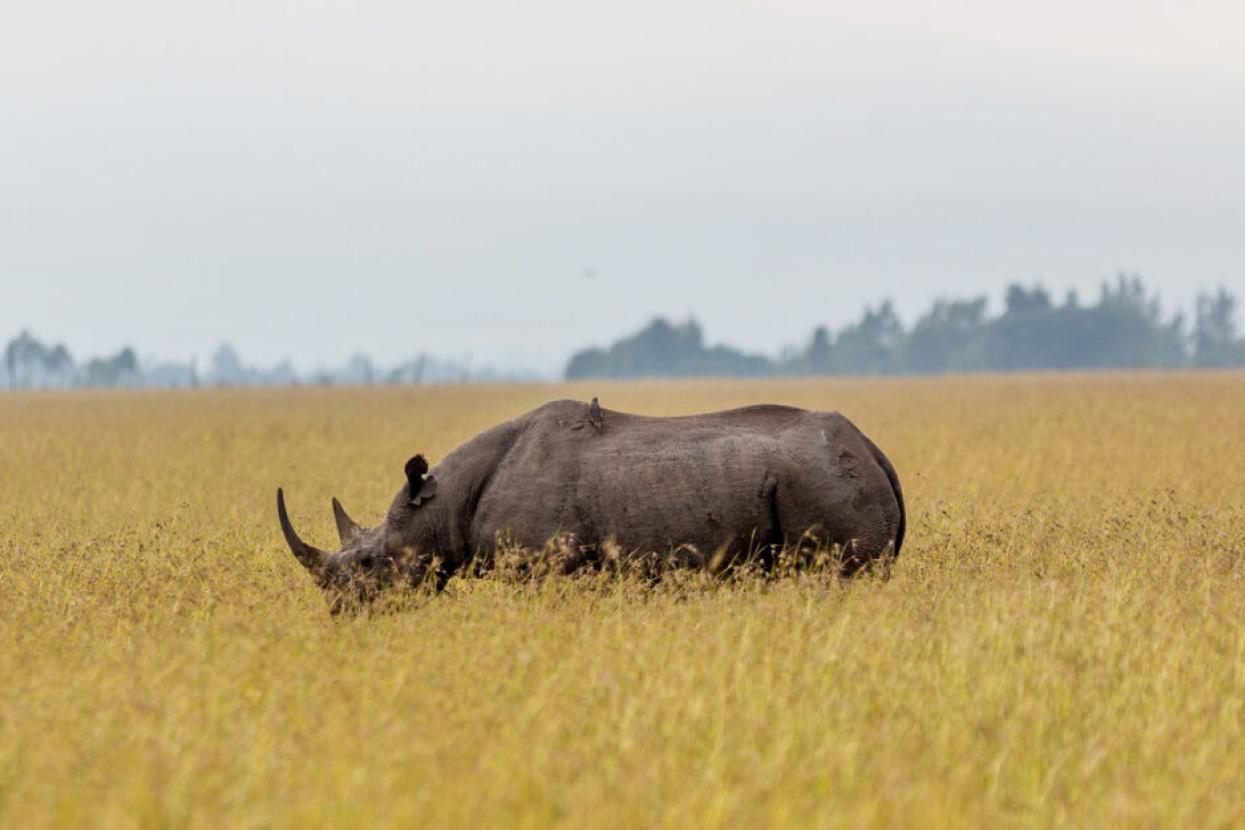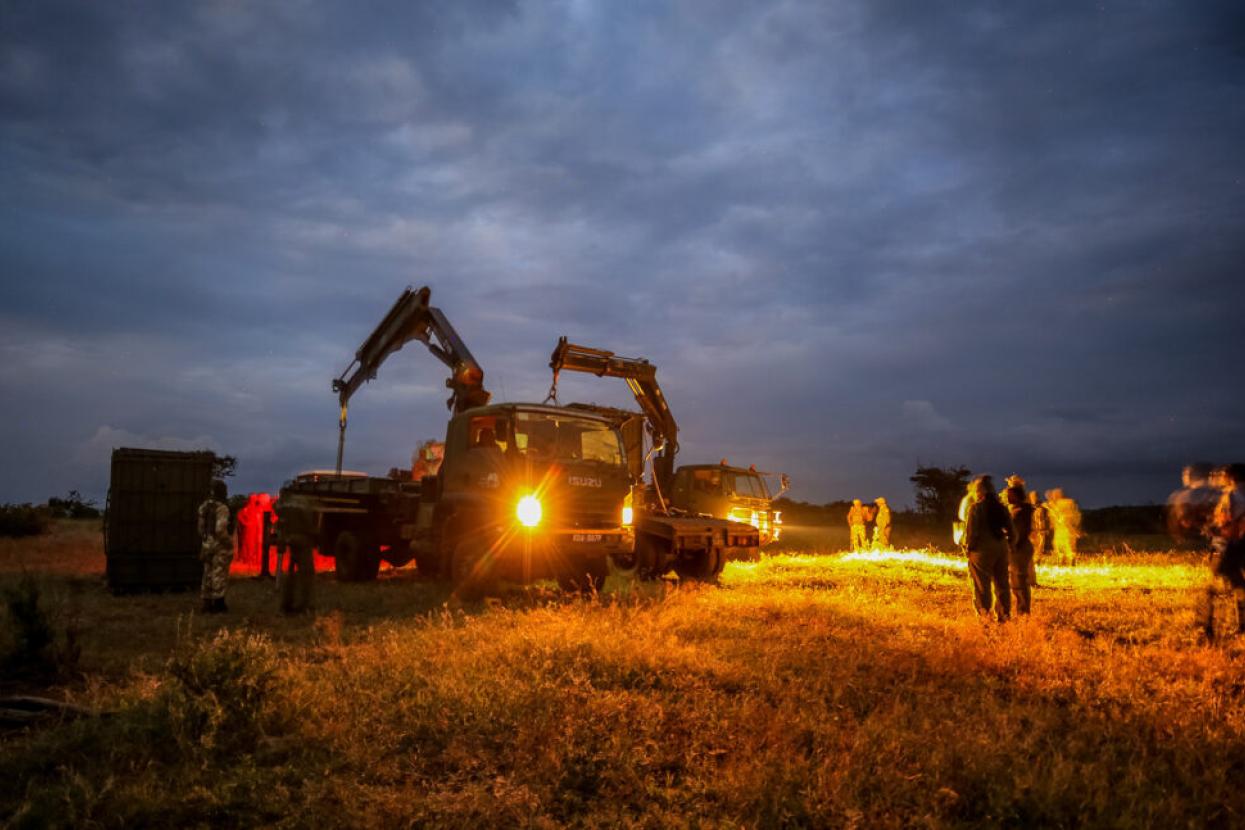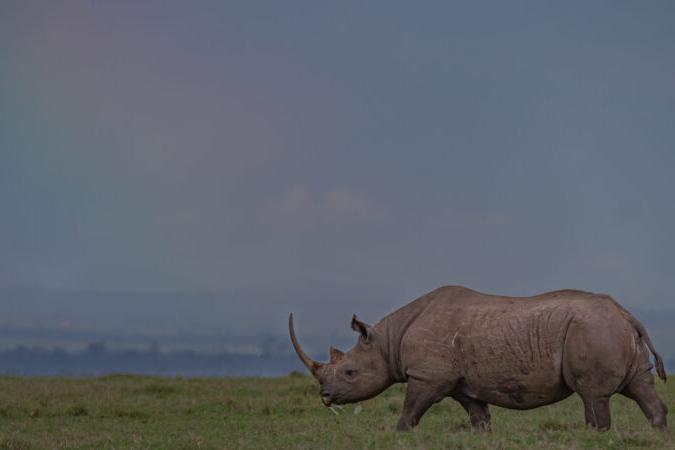
Photo credit: Rio the Photographer, Ol Pejeta Conservancy
Hope for Critically Endangered Black Rhinos
Meandering through swaying grasses and wandering past scattered shrubs, a curious black rhino explores the world around them. These are their first steps at Loisaba Conservancy in Laikipia County, Kenya—and the first steps any eastern black rhinoceros has taken on this landscape in nearly 50 years. Through an 18-month collaborative initiative with our partners to prepare for rhino reintroduction, we helped translocate this newcomer and 20 others, marking the critically endangered species’ triumphant return to this area of their native rangelands. The historic move is a crucial milestone in ongoing efforts to secure the future for eastern black rhinos.
For the first time in nearly 50 years, eastern black rhinos are back on their native rangelands at Loisaba Conservancy in Kenya.
Once abundant across Kenya, black rhino populations were decimated by rampant poaching in the 1970s and 1980s. Like other rhino species, they were targeted by the illegal wildlife trade for their horns, which are sold for decorative use and in traditional medicines. The horns are made of keratin, the same material as our hair and fingernails. These horns are thus more useful to rhinos than they are to us, and the poaching came at a cost. Kenya’s black rhino numbers crashed from over 20,000 in 1970 to fewer than 400 by 1984. Since then, other challenges, including habitat loss and modification, have continued to threaten their survival.
Today the species is making a comeback thanks to dedicated efforts by partners worldwide, including San Diego Zoo Wildlife Alliance. Populations are growing because of key conservation initiatives and anti-poaching laws. There are now around 1,000 black rhinos in Kenya, and their government is committed to doubling that count to reach a stable and sustainable population of 2,000.
With successful efforts to protect black rhinos and help populations grow, this critically endangered species is recovering from the devastating effects of poaching.
(Photo Credit: Rio the Photographer, Ol Pejeta Conservancy)
Kenya has nearly 20 black rhino sanctuaries, which are protected areas where they can thrive. However, all are nearing or have reached capacity for the total number of individuals they can sustain. This is a remarkable conservation success story, yet recovery for the species has recently plateaued because of this lack of available space.
Black rhinos are solitary animals and megaherbivores. Without enough room to establish territories with plentiful plants to browse, birth rates can slow, and juvenile survival rates can fall. Working closely with the Kenya Wildlife Service, Wildlife Research and Training Institute, Loisaba Conservancy, The Nature Conservancy, The Elewana Collection, and Space for Giants, we’re combining our conservation resources and wildlife expertise to meet this urgent need for additional safe spaces.
Together we’ve collaborated to create a new sanctuary for black rhinos in a place where they once thrived: Loisaba Conservancy. Previously home to healthy populations, the last remaining individual was lost to poaching in 1976. Now the species will be able to rebound and flourish here once more.
Except for females and their offspring, like this mom and her calf, black rhinos are solitary animals. Growing populations need more space for their continued recovery, so we worked with partners to create a sanctuary and support a rhino monitoring program at Loisaba Conservancy.
(Photo Credit: Rio the Photographer, Ol Pejeta Conservancy)
Loisaba Conservancy generously set aside around half of its 58,000 acres for these rhinos. In addition to suitable habitat, two essential elements are needed for a successful sanctuary: effective security and unwavering support from neighboring communities.
To keep reintroduced rhinos safe and preserve the area’s rich biodiversity, we supported Loisaba Conservancy in establishing an anti-poaching ranger unit and constructing a specialized fence. Encompassing 40 square miles of quality habitat and designed with rhinos’ large size and limited agility in mind, the low fence acts as a protective barrier for them while allowing other species to travel under or jump over it. Strategically placed corridor openings accommodate all wildlife except rhinos, allowing migratory species to pass through the reserve as usual. Our San Diego Zoo Wildlife Alliance-Loisaba research team is studying the ways in which species react to and use the fence in an effort to shed light on its efficacy as a model to limit the impacts of infrastructure on wildlife movement.
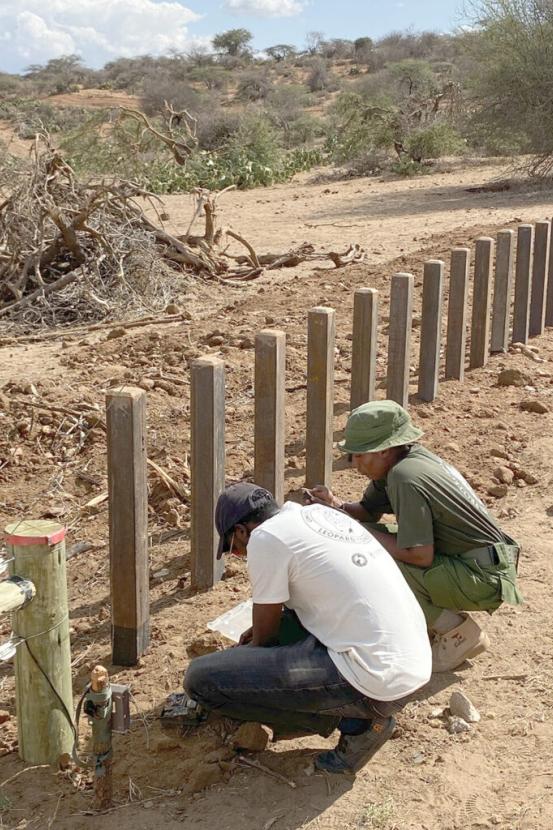
To keep black rhinos at the sanctuary safe, we supported Loisaba Conservancy in establishing an anti-poaching unit and constructing a fence protecting rhino habitat. The fence is designed to keep rhinos safe while accommodating other species’ movements through the corridor openings pictured here.
Beyond physical safeguards, our social science team guided research evaluating community input, attitudes, and expectations in advance of the rhinos’ return. The overwhelming majority of community members—88 percent of those surveyed—expressed support for the translocation plan. Most were excited at the prospect of seeing black rhinos again, as well as the potential benefits from added security, jobs, and tourism.
With the stage set, black rhinos were carefully selected from three sanctuaries in Kenya: Nairobi National Park, Ol Pejeta Conservancy, and Lewa Wildlife Conservancy. The 11 cows (females) and 10 bulls (males) chosen will form a sustainable breeding population with room to grow at Loisaba. Their movement, behavior, and health are continuously monitored by Loisaba’s rhino field team, who collaborate with our teams to help ensure successful reintroduction.
Black rhinos from three sanctuaries across Kenya were chosen to form a new breeding population at Loisaba Conservancy, with room to grow.
Rhinos can weigh up to 3,000 pounds each and moving them was no easy feat. The Kenya Wildlife Service led the translocation efforts, moving three rhinos at a time to their new home via trucks. With the expertise of our partners, including highly skilled veterinarians, all 21 arrived safely over the course of a few weeks. As they continue to settle in at Loisaba, we’re monitoring their health and behavior to ensure they thrive.
Through efforts led by the Kenya Wildlife Service, 21 eastern black rhinos were successfully translocated to Loisaba.
We’re deeply honored to be a part of this groundbreaking milestone and conservation alliance. By working together, we’re reminded of the transformative power of partnership and the resilience of wildlife when given the opportunity to flourish. Hope is on the horizon for this critically endangered species, and every step forward helps ensure they’ll thrive for generations to come.
You make these trailblazing conservation efforts possible. Discover how you’re making a difference for black rhinos and other vulnerable African wildlife through our Savanna Conservation Hub.


